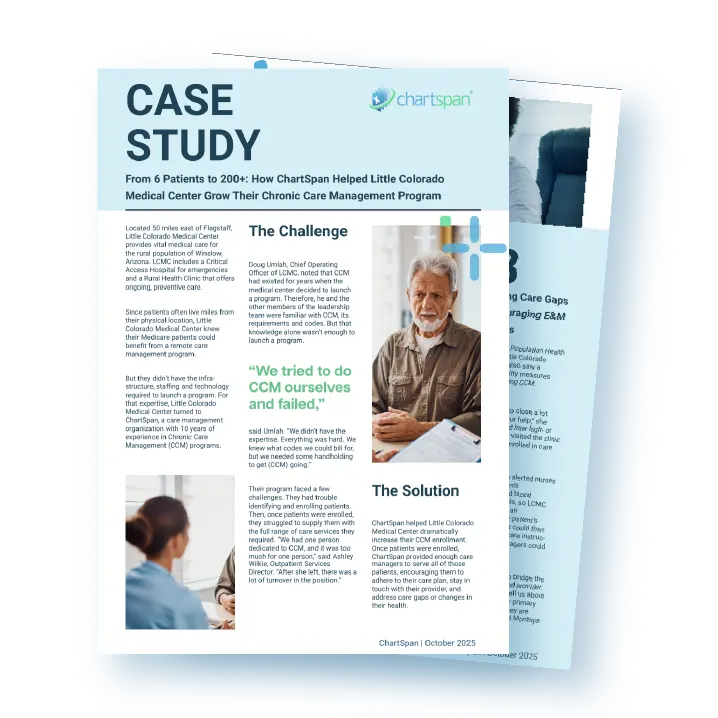
Talk with a ChartSpan Representative Today!
Our team is ready to help you improve patient care and outcomes.
Blog
Provider’s Guide to Preventive Health Screenings
Preventive health screenings can be the difference between catching a disease early, when it’s most treatable, and facing it at a stage where options are more limited. They not only improve the odds of successful treatment but also help preserve quality of life. Yet despite the proven benefits of preventive screenings, too many patients don’t receive them, even in well-run practices.
Missed screenings happen for many reasons: lack of patient awareness, difficulty tracking follow-up care, or the challenge of coordinating across multiple providers.
This guide breaks down recommended screenings by age group, examines why they’re often overlooked, and explores how care management programs like Chronic Care Management (CCM) and Advanced Primary Care Management (APCM) can assist in closing those gaps. We’ll also look at how Annual Wellness Visit (AWV) technology can make preventive care more consistent, efficient, and effective for both providers and patients.
The importance of preventive screenings for patient outcomes
Preventive health screenings are one of the most effective tools providers have to improve outcomes, especially for patients with chronic conditions. By identifying risk factors or early signs of disease before symptoms develop, preventive screenings create the opportunity for timely, targeted intervention. This proactive approach can halt or slow the progression of chronic conditions, reduce the severity of complications, and ultimately protect patients’ quality of life.
Detecting conditions early often means they can be addressed with less intensive, less invasive, and less costly treatments. For example, a routine blood test that flags elevated cholesterol allows for early lifestyle or medication interventions, avoiding the far greater costs and health consequences of advanced cardiovascular disease. In this way, preventive screenings not only preserve patients’ health but also help reduce overall demand on healthcare resources.
When incorporated consistently into patient care, preventive screenings shift the focus from managing illness to maintaining wellness, creating lasting benefits for patients, providers, and the healthcare system as a whole.
Why preventive screenings are commonly missed
Understanding why patients miss or avoid preventive screenings is an important step toward closing care gaps, providing patients with the right information, and encouraging participation in screenings that match a person’s age and risk factors. Common reasons for missing screenings include:
Care coordination gaps
Patients may receive screenings at multiple practices or from different specialists, making it difficult for any single provider to have a complete picture of their preventive care. Care managers can help bridge this gap by asking patients about their most recent screenings and centralizing that information in a care plan for the patient’s care team.
Limited patient engagement
Many patients only schedule provider visits when they’re sick, which means preventive screenings often go overlooked. Without prompts or reminders, these patients may not recognize the value of attending routine checkups.
Lack of understanding
Some patients are unaware of which screenings are recommended or why they matter. Others may feel anxiety or fear about the results, leading them to delay testing or avoid it altogether. Educating patients about the importance of preventive screenings and the risks of postponing them can help improve participation. Care managers also explain what each screening entails, easing fears about the process. For example, they may clarify that an A1c test is only a quick blood draw, or that colorectal cancer screening can be done with a simple at-home stool test rather than a colonoscopy.
Accessibility barriers
Busy schedules often make it difficult for patients to prioritize preventive screenings. For patients in rural areas, distance from providers, lack of public transportation, and fewer local resources can further limit access to routine care. With a care coordination partner, your patients can receive assistance with scheduling and transportation, making preventive screenings more accessible.
Preventive screenings by age group
Preventive care needs evolve over a patient’s lifetime, with certain screenings becoming more important as risk factors increase with age. Understanding which tests are recommended at each age can help providers identify risks earlier, guide timely treatment, and reduce long-term healthcare costs. The chart below outlines key screenings for adults, from early adulthood through age 65 and beyond.
| Age group | Focus | Recommended preventive screenings |
| 18–39 | Foundational screenings and early detection of silent conditions. |
|
| 40–49 | Adding screenings for cancers that begin to show increased risk in midlife. |
|
| 50–64 | High vigilance for chronic disease and multiple cancers. |
|
| 65 and older | Maintaining health, preventing disability, and catching late-life risks early. |
Adults over 65 may also require other screenings, like cognitive, Activities of Daily Living, or Durable Medical Equipment screenings, based on individual needs.
The preventive screenings needed for each person will vary based on family history, risk factors, and the health conditions they already have. Ultimately, it is up to the patient’s care team to recommend which screenings are most relevant—but it is still easy for patients to miss a screening if they don’t receive ongoing reminders and education. Medicare care management programs can assist in promoting preventive screenings.
How CCM and APCM help prevent missed screenings
Chronic Care Management (CCM) and Advanced Primary Care Management (APCM) programs extend care beyond the walls of the clinic, keeping patients engaged and aware of the preventive services available to them. Between regular touchpoints, coordinated record-keeping, and patient-centered planning, these programs help ensure patients don’t miss important screenings while also improving quality performance for providers.
Chronic Care Management is a Medicare program that offers patients with two or more chronic conditions who choose to enroll 20 minutes of coordinated care every month. Advanced Primary Care Management, which officially launched in 2025, offers all Medicare patients who choose to enroll preventive care services, with the amount of time spent on services each month varying according to the patient’s needs.
1. Monthly touchpoints
CCM and APCM programs create consistent, proactive connections with patients—connections that practices who see patients once a year or less might lack. Through structured monthly telephonic or digital interactions and time spent on care coordination, care managers can confirm whether patients have completed recommended screenings, update records with new information, and identify any tests that may be overdue. This ongoing monitoring helps ensure preventive screenings aren’t missed between office visits.
2. Care coordination
Because preventive care often spans multiple providers, critical information can become scattered, which can make it challenging for one provider to maintain a clear, up-to-date record of a patient’s preventive care. CCM and APCM care teams act as a hub, gathering records from different sources, updating the patient’s digital care plan, and maintaining a comprehensive screening history. With preventive care screenings and assessments in one place, providers can act quickly and confidently on overdue services.
Learn more: What Is Care Coordination? Examples, Services, & Best Practices
3. Care planning
Both APCM and CCM programs require care managers to develop personalized care plans in collaboration with patients, and they may incorporate preventive screenings based on individual health risks, lifestyle, and goals. This process turns screening recommendations into concrete steps and, by involving patients in the planning process, builds a sense of ownership and understanding that increases follow-through.
4. Patient education
Education is woven into care management interactions, helping address one of the most common reasons screenings are missed: a lack of understanding about their purpose or urgency. Care managers explain the value of specific screenings, address patient concerns, and provide educational materials that reinforce the importance of timely testing. For many patients, these conversations transform preventive screenings from an abstract recommendation into an essential, meaningful part of their ongoing care.
5. Scheduling support and reminders
Even patients who understand the importance of screenings can run into practical barriers. Care managers can help patients overcome hurdles by assisting with appointment scheduling and reminding patients of upcoming appointments. They can also assist with arranging transportation and following up after preventive screenings to confirm completion. This logistical support removes friction that can otherwise delay or derail preventive care.
6. Quality improvement and reporting
Because APCM programs track quality measures tied to preventive screenings and quality measures are an optional, but important, component of CCM, providers gain access to actionable data that can drive outreach to high-risk patients, inform care strategies, and support CMS performance goals.
For organizations using ChartSpan’s CCM and APCM services, these capabilities are fully supported by dedicated care coordination teams who handle outreach, documentation, and follow-up, with notifications to the practice when clinical staff or the provider need to offer support. This allows practices to maintain consistent, data-driven preventive care efforts without adding a large amount of work to their daily workload, keeping more patients current with essential screenings.
How AWV technology can streamline preventive care
Annual Wellness Visits (AWVs) provide a structured opportunity to complete basic assessments—such as initial depression screenings—in the waiting room while the patient waits to see their provider. AWVs also provide an opportunity to identify which preventive screenings a patient is due for based on age, medical history, and risk factors.
ChartSpan’s RapidAWV™ software uses customizable Health Risk Assessments (HRAs) to generate individualized preventive care plans tailored to each patient’s needs, risks, and lifestyle factors. The information collected through the HRA enables providers to schedule follow-up appointments for any recommended screenings, helping patients stay on track with their preventive care.
By incorporating AWV technology into routine practice, providers can more efficiently identify overdue screenings and follow up with patients in a timely, personalized way, making preventive care more consistent and effective.
Stay on top of preventive health screenings with ChartSpan
Medicare programs like Chronic Care Management, Advanced Primary Care Management, and Annual Wellness Visits are designed to support preventive health, but successfully delivering these services can be complex. ChartSpan partners with practices to simplify the process, reduce administrative burden, and ensure patients receive the screenings they need on time.
Our care managers work directly with patients to schedule appointments, coordinate across providers, and keep care plans up to date with recommended screenings. Patients also benefit from help accessing test results, assistance with transportation, and 24/7 access to a care line—services that help remove common barriers to follow-through and build stronger engagement.
ChartSpan’s RapidAWV™ adds another layer of efficiency by identifying overdue screenings during wellness visits and generating individualized care plans. This ensures preventive needs are clearly documented and acted on in a timely manner.
By partnering with ChartSpan, your practice can deliver CCM, APCM, and AWVs more effectively, helping identify care gaps, strengthen patient relationships, and improve both quality outcomes and CMS quality performance measures. Talk to an expert to learn how ChartSpan can support your practice’s preventive care programs.
You may also like:
Subscribe for More Insights
Get valuable resources delivered straight to your inbox.
"*" indicates required fields






